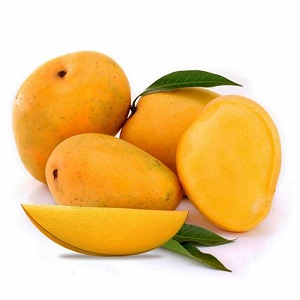
🥭 Banginapalli Mango
📍 Origin
Named after Banganapalle in Andhra Pradesh, India. This variety makes up approximately 70% of the state’s mango cultivation and was granted a Geographical Indication (GI) tag in 2017.
👁️ Appearance
Oblong-oval fruit, around 20 cm long, with thin, smooth yellow skin and firm, fiber-free flesh.
🍯 Sweetness Meter
⏰ Shelf Life
Known for its excellent shelf stability—stays fresh well beyond many other mango types when properly stored.
🌸 Aroma
Mild tropical fragrance that intensifies as the fruit ripens, with sweet fruity notes.
😋 Flavor
Naturally sweet with a mild tropical flavor; the fiberless texture makes it perfect for eating fresh, in juices, desserts, or canning.
💡 Tips
Store unripe mangoes at room temperature until they soften and emit a fruity aroma, then transfer to the refrigerator to preserve freshness.
Once ripe, enjoy them within 2–5 days for optimal taste and texture.
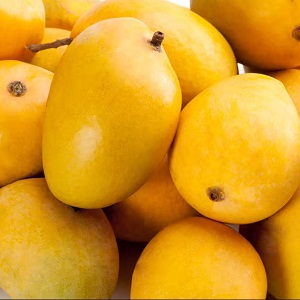
👑 Alphonso Mango
📍 Origin
Alphonso (also known as Hapus) is a prized Indian mango cultivar named after Portuguese viceroy Afonso de Albuquerque. Its roots trace back to 16th-century Goa and later spread to regions like Maharashtra, Goa, and Gujarat.
👁️ Appearance
Golden-yellow skin with a reddish blush at the top during peak ripeness. Non-fibrous, rich, creamy, deep saffron-orange pulp. Typically weighing between 150–300g.
🍯 Sweetness Meter
⏰ Shelf Life
Moderate shelf life. Best consumed within 3-5 days of ripening. Handle with care due to delicate skin.
🌸 Aroma
Features a captivating aroma described as floral, musky, and sweet with enchanting fragrance that fills the room.
😋 Flavor
The flavor delivers a high-sugar, tropical punch with notes of honey, melon, and stone fruit, embodying its “King of Mangoes” title.
💡 Tips
Exported as luxury fruit to Japan, Europe, and Korea due to its exquisite taste and fragrance.
Season: March to June. Best enjoyed fresh or in premium desserts.
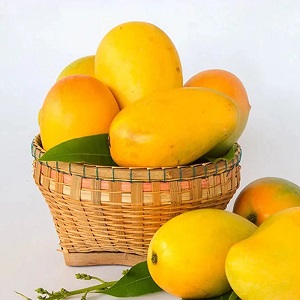
🧡 Kesar Mango
📍 Origin
Grown at the foothills of Girnar in Gujarat, India. The Gir Kesar mango obtained its Geographical Indication (GI) status in 2011.
👁️ Appearance
Medium-sized, roundish with a distinct curved tip; skin ranges from greenish to yellow, while the pulp is deep saffron-orange, smooth, and fragrant.
🍯 Sweetness Meter
⏰ Shelf Life
Good shelf life when stored properly. Can last 4-6 days when ripe at room temperature, longer when refrigerated.
🌸 Aroma
Intensely aromatic with sweet, floral notes that become more pronounced as the fruit ripens.
😋 Flavor
Intensely sweet and aromatic, with a fiberless flesh that remains creamy even when ripe. Rich saffron-like taste.
💡 Tips
Season: April–May (planting starts post-monsoon in October).
Rich in vitamins A, C, E, and B6; one of India’s top mango exports, second only to Alphonso.
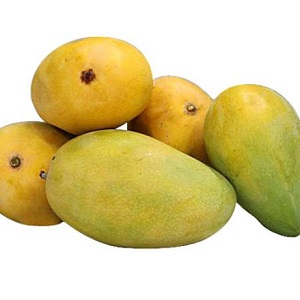
🍯 Chinna Rasalu Mango
📍 Origin
A traditional Indian cultivar originating from Nuzvid in Andhra Pradesh, also popular across Telangana. No GI status currently.
👁️ Appearance
Medium-sized (250–350g), with bright yellow skin at peak ripeness. The pulp is fibrous yet tender.
🍯 Sweetness Meter
⏰ Shelf Life
Short shelf life due to high juice content. Best consumed immediately upon ripening. Can be refrigerated for 2–3 days when ripe.
🌸 Aroma
Sweet, intense fruity aroma that signals peak ripeness. Very fragrant when ready to eat.
😋 Flavor
Exceptionally juicy and sweet—earning it the nickname “Cheruku Rasalu” (sugar-cane mango) in reference to its sugarcane-like sweetness.
💡 Tips
Perfect for squeezing whole, blending into juices or shakes—especially because of its juicy, fibrous pulp.
Season: Mid-May to mid-June. Ideal for juice extraction that’s often frozen in bulk.
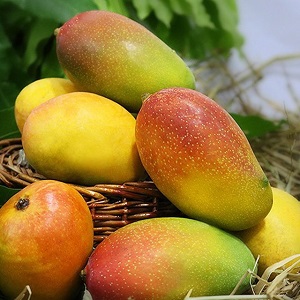
🌅 Suvarna Rekha Mango
📍 Origin
Also known as Chinna-Suvarnarekha, Sundari, or Lal Sundari, this medium-sized mango originates from Andhra Pradesh and Odisha in India. No GI status currently.
👁️ Appearance
Ovate-oblong fruit with yellow to light cadmium skin and a crimson-jasper blush, often dotted with pale speckles.
🍯 Sweetness Meter
⏰ Shelf Life
Good shelf life as an early season variety. Can be stored for 4-5 days when ripe, longer when refrigerated.
🌸 Aroma
Very aromatic and refreshing with citrus undertones that become more prominent early in the season.
😋 Flavor
Sweet, juicy, and fiberless pulp. Flavor notes include citrus and peach, with a mild tang—especially early in the season.
💡 Tips
Great for home gardeners: grafted trees begin fruiting in 2-3 years with proper care.
Season: April-May. One of the early-season varieties with reliable yield.
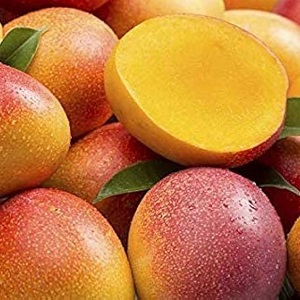
👑 Himayath (Imam Pasand)
📍 Origin
Known interchangeably as Himayath, Imam Pasand, Himam Pasand, and Humayun Pasand, this premium cultivar hails from Andhra Pradesh, Telangana, and Tamil Nadu. No GI status currently.
👁️ Appearance
Large-sized (300–800g), oblong to elongated shape, with greenish-yellow skin turning golden upon ripening, often with a reddish blush.
🍯 Sweetness Meter
⏰ Shelf Life
Good shelf life due to large size and thick skin. Can last 5-7 days when ripe, longer when refrigerated.
🌸 Aroma
Strong sweet fragrance, often likened to honey, citrus, floral, and even subtle coconut-lime notes. Very aromatic.
😋 Flavor
Intensely sweet and rich, with layered undertones of citrus and spices. Notably fiberless and creamy, with firm yet melt-in-your-mouth flesh.
💡 Tips
Royal heritage: cherished by the Nawabs of Hyderabad. “Himayat” means protection in Urdu.
Season: Mid-April to June. Often dubbed “King of Mangoes” by enthusiasts.
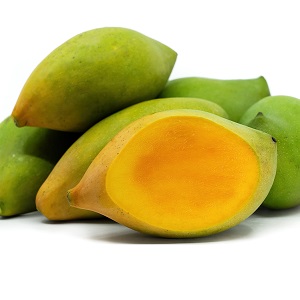
🦜 Totapuri Mango
📍 Origin
Indigenous to South India (Andhra Pradesh, Karnataka, Telangana) and also grown in Sri Lanka. Known as Totapuri or Ginimoothi (“parrot face/beak”). No GI status currently.
👁️ Appearance
Medium to large mango, measuring ~17–20 cm in length, with a distinct elongated shape and pointed tip; the skin is thick and transitions from green to yellow with possible red blush.
🍯 Sweetness Meter
⏰ Shelf Life
Excellent shelf life – known for being versatile and long-lasting due to thick skin. Can be stored for extended periods.
🌸 Aroma
Mild, fresh aroma that varies depending on ripeness stage. Less intense than other varieties but pleasant.
😋 Flavor
Firm, slightly chewy or semi-crunchy flesh. Taste is gently sweet with a tangy-acidic bite, ideal for both green and ripe consumption. The skin is edible and not bitter.
💡 Tips
Green-stage: Slice raw with salt and chili powder for a tangy snack.
Season: April-August. Versatile for fresh eating, pickles, juices, or pulps.
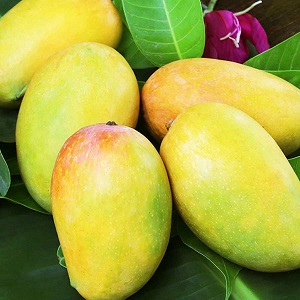
🏛️ Dasheri Mango
📍 Origin
Originating near Dasheri Village in Kakori, Lucknow (Uttar Pradesh) during the 18th century, first grafted under the stewardship of Nawabs. Malihabad remains the main cultivar hub with the “mother tree” still existing today. No GI status currently.
👁️ Appearance
Small to medium size, 9–15 cm long, straight-oval with blunt ends. Skin transitions from greenish to golden yellow; flesh is orange, juicy, smooth, and virtually fiberless.
🍯 Sweetness Meter
⏰ Shelf Life
Moderate shelf life. Best consumed within 3-4 days of ripening. Handle gently due to delicate skin.
🌸 Aroma
Fragrant with tropical, nectar-like scent with fruity-floral undertones that intensify when ripe.
😋 Flavor
Exceptionally sweet with mild tang and fruity-floral undertones. Virtually fiberless texture makes it perfect for fresh consumption.
💡 Tips
Exported to Southeast Asian markets like Singapore, Malaysia, Philippines, and Hong Kong.
Perfect for fresh eating, juices, smoothies, desserts, and traditional sweets like aam papad.
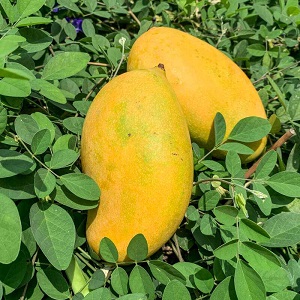
🌟 Mallika Mango
📍 Origin
A popular hybrid cross between Neelum and Dasheri, developed by Dr. Ramnath Singh. No GI status as it’s a modern hybrid variety.
👁️ Appearance
Medium-sized fruit with attractive golden-yellow skin when ripe. Smooth, fiberless flesh with excellent presentation quality.
🍯 Sweetness Meter
⏰ Shelf Life
Good shelf life when properly handled. Pick mature-green and ripen at room temperature for 5-10 days, then refrigerate.
🌸 Aroma
Pleasant, sweet aroma with honey and citrus notes. Aromatic appeal recognized at mango festivals.
😋 Flavor
Exceptionally sweet, fiberless flesh with pronounced citrus, melon, and honey notes—often described as one of the world’s best dessert mangoes.
💡 Tips
Container friendly: compact tree size (~10–15 ft) makes it suitable for patio pots or smaller yards.
Season: June-July. Celebrated at mango festivals like Aam Mahotsav in Lucknow.